Management 1 Essay: Creativity, Innovation, and Design Thinking
VerifiedAdded on 2022/10/06
|7
|2021
|500
Essay
AI Summary
This essay examines the role of creativity, innovation, and design thinking within organizations, arguing against the notion that these activities are solely dependent on individual employees. It defines these key concepts and presents arguments supported by theories like the componential theory of creativity and the interactionist perspective. The essay utilizes real-world examples from successful companies such as Google and 3M to illustrate how collaborative efforts and teamwork are crucial for fostering innovation and achieving competitive advantages. It highlights how these organizations leverage information sharing, open communication, and team-based approaches to drive creativity and design thinking processes. The essay concludes that while individual contributions are important, the collective efforts of teams are fundamental to successful innovation, creativity, and design thinking in modern business environments.
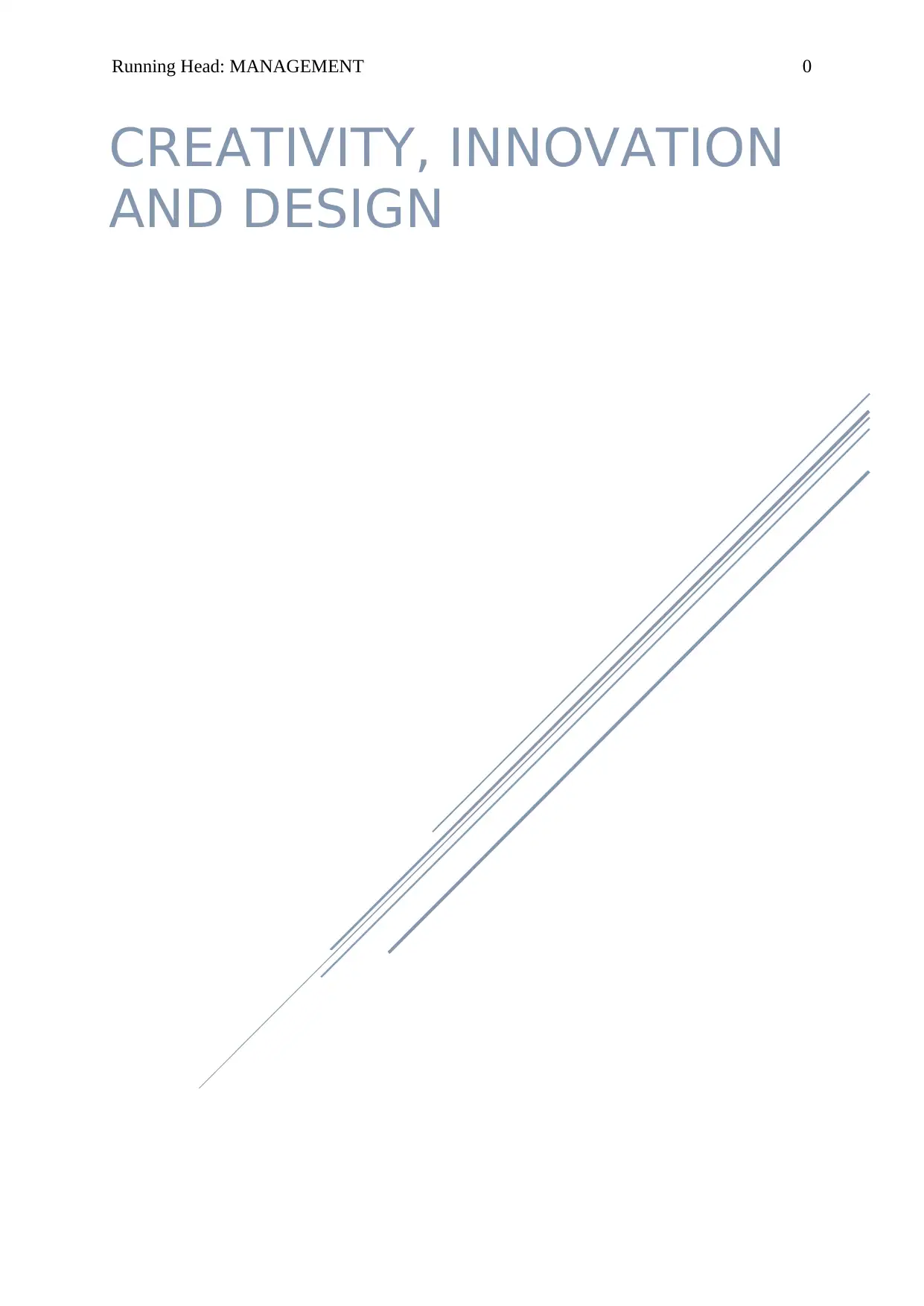
Running Head: MANAGEMENT 0
CREATIVITY, INNOVATION
AND DESIGN
CREATIVITY, INNOVATION
AND DESIGN
Paraphrase This Document
Need a fresh take? Get an instant paraphrase of this document with our AI Paraphraser
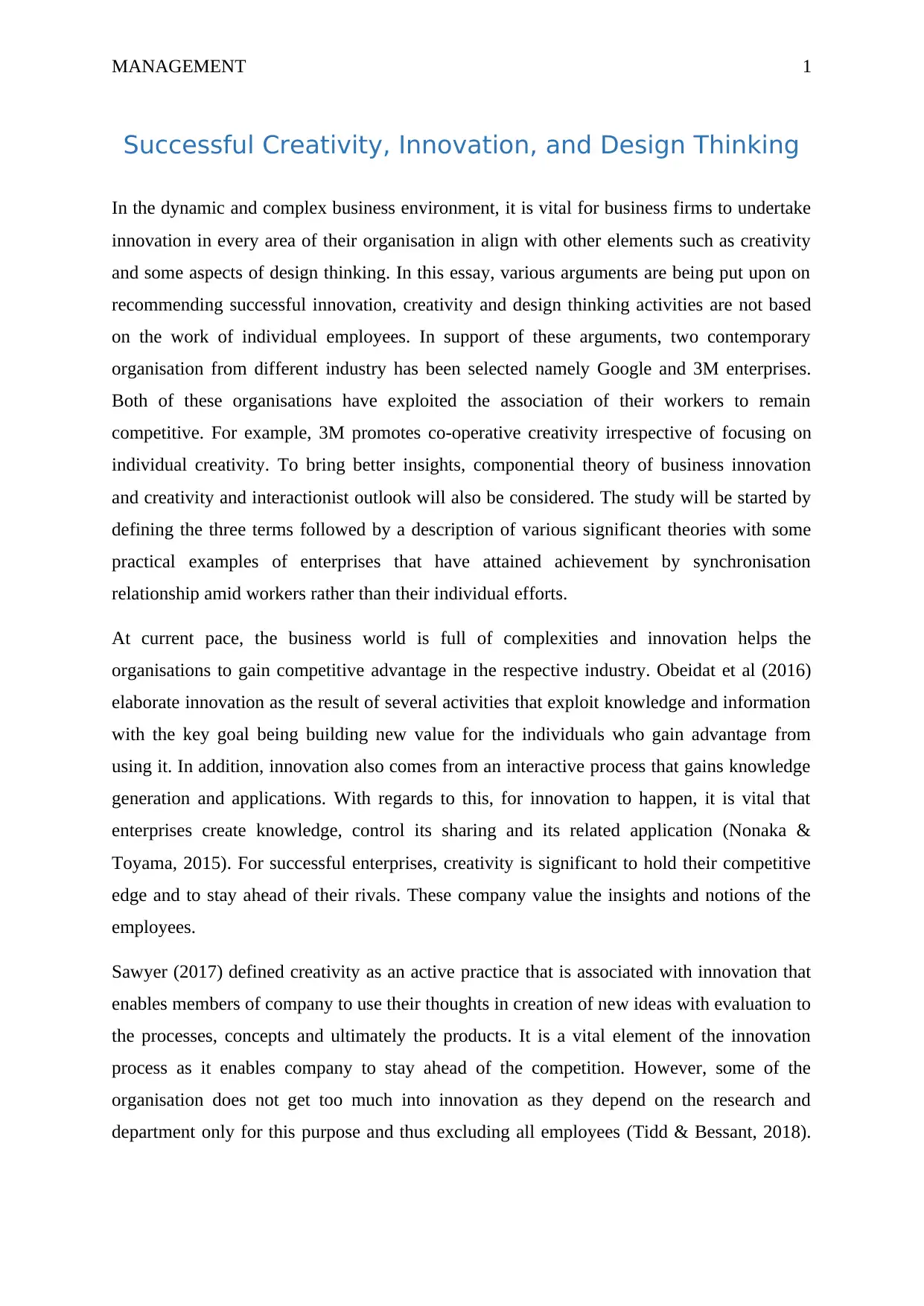
MANAGEMENT 1
Successful Creativity, Innovation, and Design Thinking
In the dynamic and complex business environment, it is vital for business firms to undertake
innovation in every area of their organisation in align with other elements such as creativity
and some aspects of design thinking. In this essay, various arguments are being put upon on
recommending successful innovation, creativity and design thinking activities are not based
on the work of individual employees. In support of these arguments, two contemporary
organisation from different industry has been selected namely Google and 3M enterprises.
Both of these organisations have exploited the association of their workers to remain
competitive. For example, 3M promotes co-operative creativity irrespective of focusing on
individual creativity. To bring better insights, componential theory of business innovation
and creativity and interactionist outlook will also be considered. The study will be started by
defining the three terms followed by a description of various significant theories with some
practical examples of enterprises that have attained achievement by synchronisation
relationship amid workers rather than their individual efforts.
At current pace, the business world is full of complexities and innovation helps the
organisations to gain competitive advantage in the respective industry. Obeidat et al (2016)
elaborate innovation as the result of several activities that exploit knowledge and information
with the key goal being building new value for the individuals who gain advantage from
using it. In addition, innovation also comes from an interactive process that gains knowledge
generation and applications. With regards to this, for innovation to happen, it is vital that
enterprises create knowledge, control its sharing and its related application (Nonaka &
Toyama, 2015). For successful enterprises, creativity is significant to hold their competitive
edge and to stay ahead of their rivals. These company value the insights and notions of the
employees.
Sawyer (2017) defined creativity as an active practice that is associated with innovation that
enables members of company to use their thoughts in creation of new ideas with evaluation to
the processes, concepts and ultimately the products. It is a vital element of the innovation
process as it enables company to stay ahead of the competition. However, some of the
organisation does not get too much into innovation as they depend on the research and
department only for this purpose and thus excluding all employees (Tidd & Bessant, 2018).
Successful Creativity, Innovation, and Design Thinking
In the dynamic and complex business environment, it is vital for business firms to undertake
innovation in every area of their organisation in align with other elements such as creativity
and some aspects of design thinking. In this essay, various arguments are being put upon on
recommending successful innovation, creativity and design thinking activities are not based
on the work of individual employees. In support of these arguments, two contemporary
organisation from different industry has been selected namely Google and 3M enterprises.
Both of these organisations have exploited the association of their workers to remain
competitive. For example, 3M promotes co-operative creativity irrespective of focusing on
individual creativity. To bring better insights, componential theory of business innovation
and creativity and interactionist outlook will also be considered. The study will be started by
defining the three terms followed by a description of various significant theories with some
practical examples of enterprises that have attained achievement by synchronisation
relationship amid workers rather than their individual efforts.
At current pace, the business world is full of complexities and innovation helps the
organisations to gain competitive advantage in the respective industry. Obeidat et al (2016)
elaborate innovation as the result of several activities that exploit knowledge and information
with the key goal being building new value for the individuals who gain advantage from
using it. In addition, innovation also comes from an interactive process that gains knowledge
generation and applications. With regards to this, for innovation to happen, it is vital that
enterprises create knowledge, control its sharing and its related application (Nonaka &
Toyama, 2015). For successful enterprises, creativity is significant to hold their competitive
edge and to stay ahead of their rivals. These company value the insights and notions of the
employees.
Sawyer (2017) defined creativity as an active practice that is associated with innovation that
enables members of company to use their thoughts in creation of new ideas with evaluation to
the processes, concepts and ultimately the products. It is a vital element of the innovation
process as it enables company to stay ahead of the competition. However, some of the
organisation does not get too much into innovation as they depend on the research and
department only for this purpose and thus excluding all employees (Tidd & Bessant, 2018).
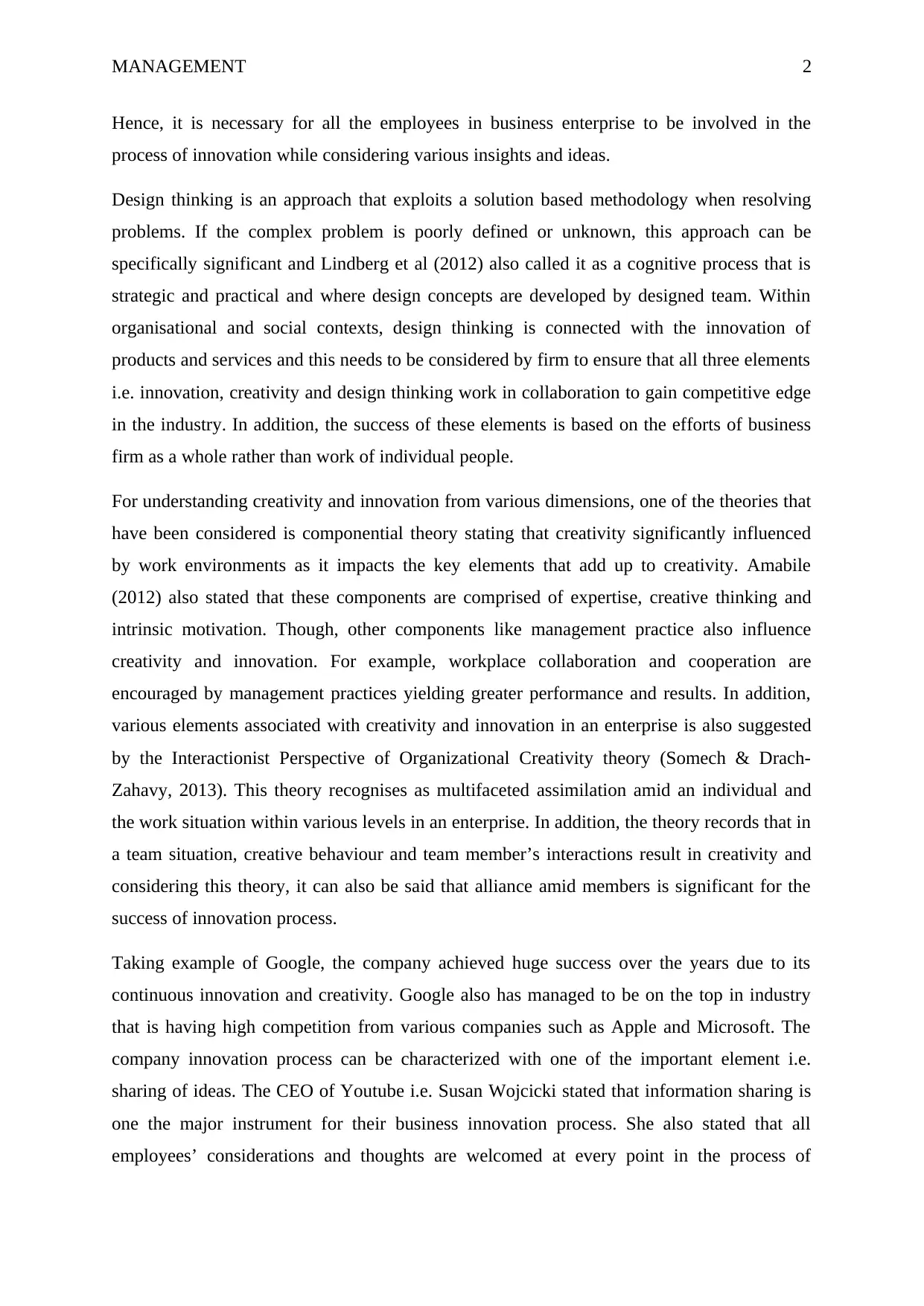
MANAGEMENT 2
Hence, it is necessary for all the employees in business enterprise to be involved in the
process of innovation while considering various insights and ideas.
Design thinking is an approach that exploits a solution based methodology when resolving
problems. If the complex problem is poorly defined or unknown, this approach can be
specifically significant and Lindberg et al (2012) also called it as a cognitive process that is
strategic and practical and where design concepts are developed by designed team. Within
organisational and social contexts, design thinking is connected with the innovation of
products and services and this needs to be considered by firm to ensure that all three elements
i.e. innovation, creativity and design thinking work in collaboration to gain competitive edge
in the industry. In addition, the success of these elements is based on the efforts of business
firm as a whole rather than work of individual people.
For understanding creativity and innovation from various dimensions, one of the theories that
have been considered is componential theory stating that creativity significantly influenced
by work environments as it impacts the key elements that add up to creativity. Amabile
(2012) also stated that these components are comprised of expertise, creative thinking and
intrinsic motivation. Though, other components like management practice also influence
creativity and innovation. For example, workplace collaboration and cooperation are
encouraged by management practices yielding greater performance and results. In addition,
various elements associated with creativity and innovation in an enterprise is also suggested
by the Interactionist Perspective of Organizational Creativity theory (Somech & Drach-
Zahavy, 2013). This theory recognises as multifaceted assimilation amid an individual and
the work situation within various levels in an enterprise. In addition, the theory records that in
a team situation, creative behaviour and team member’s interactions result in creativity and
considering this theory, it can also be said that alliance amid members is significant for the
success of innovation process.
Taking example of Google, the company achieved huge success over the years due to its
continuous innovation and creativity. Google also has managed to be on the top in industry
that is having high competition from various companies such as Apple and Microsoft. The
company innovation process can be characterized with one of the important element i.e.
sharing of ideas. The CEO of Youtube i.e. Susan Wojcicki stated that information sharing is
one the major instrument for their business innovation process. She also stated that all
employees’ considerations and thoughts are welcomed at every point in the process of
Hence, it is necessary for all the employees in business enterprise to be involved in the
process of innovation while considering various insights and ideas.
Design thinking is an approach that exploits a solution based methodology when resolving
problems. If the complex problem is poorly defined or unknown, this approach can be
specifically significant and Lindberg et al (2012) also called it as a cognitive process that is
strategic and practical and where design concepts are developed by designed team. Within
organisational and social contexts, design thinking is connected with the innovation of
products and services and this needs to be considered by firm to ensure that all three elements
i.e. innovation, creativity and design thinking work in collaboration to gain competitive edge
in the industry. In addition, the success of these elements is based on the efforts of business
firm as a whole rather than work of individual people.
For understanding creativity and innovation from various dimensions, one of the theories that
have been considered is componential theory stating that creativity significantly influenced
by work environments as it impacts the key elements that add up to creativity. Amabile
(2012) also stated that these components are comprised of expertise, creative thinking and
intrinsic motivation. Though, other components like management practice also influence
creativity and innovation. For example, workplace collaboration and cooperation are
encouraged by management practices yielding greater performance and results. In addition,
various elements associated with creativity and innovation in an enterprise is also suggested
by the Interactionist Perspective of Organizational Creativity theory (Somech & Drach-
Zahavy, 2013). This theory recognises as multifaceted assimilation amid an individual and
the work situation within various levels in an enterprise. In addition, the theory records that in
a team situation, creative behaviour and team member’s interactions result in creativity and
considering this theory, it can also be said that alliance amid members is significant for the
success of innovation process.
Taking example of Google, the company achieved huge success over the years due to its
continuous innovation and creativity. Google also has managed to be on the top in industry
that is having high competition from various companies such as Apple and Microsoft. The
company innovation process can be characterized with one of the important element i.e.
sharing of ideas. The CEO of Youtube i.e. Susan Wojcicki stated that information sharing is
one the major instrument for their business innovation process. She also stated that all
employees’ considerations and thoughts are welcomed at every point in the process of
⊘ This is a preview!⊘
Do you want full access?
Subscribe today to unlock all pages.

Trusted by 1+ million students worldwide
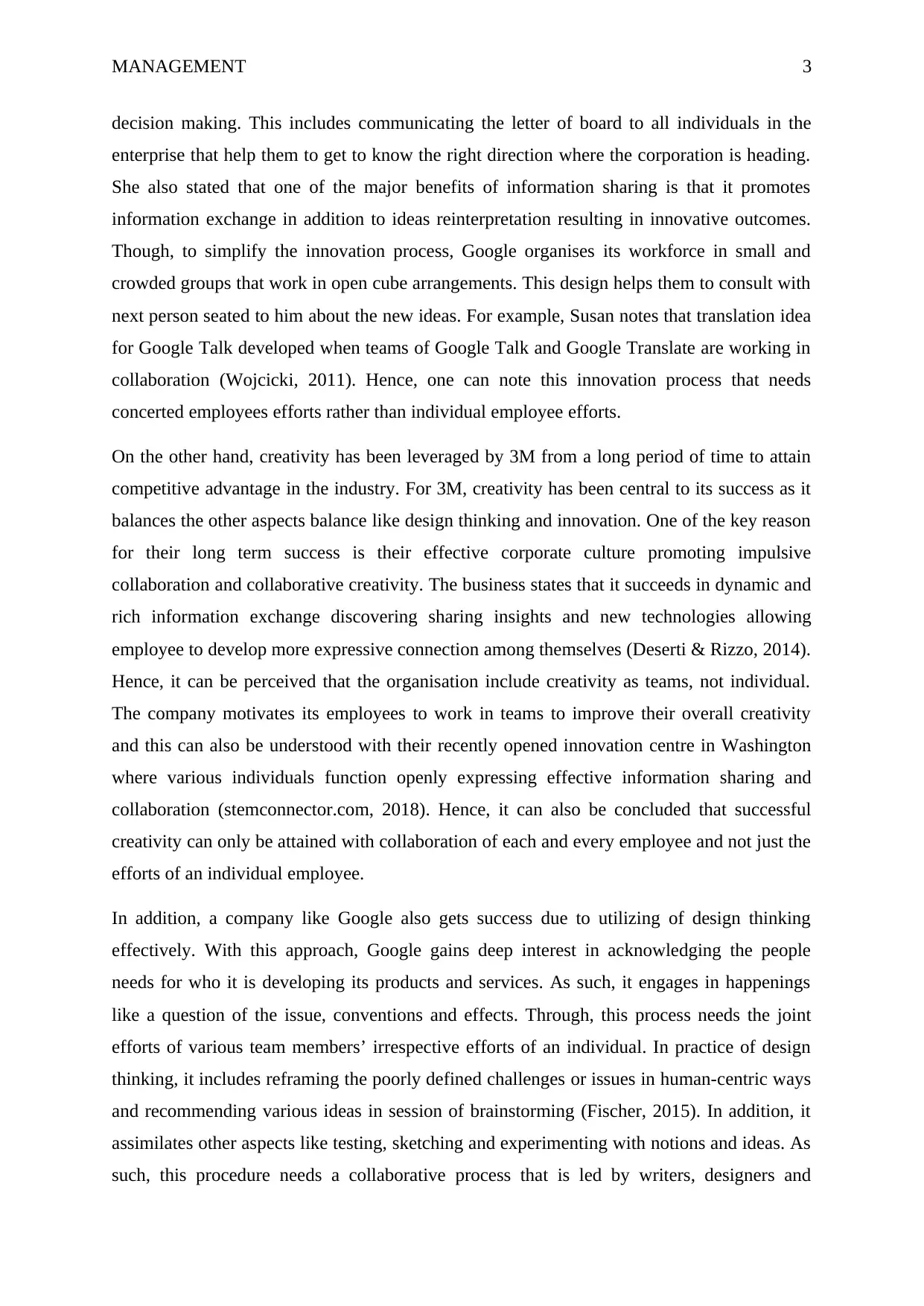
MANAGEMENT 3
decision making. This includes communicating the letter of board to all individuals in the
enterprise that help them to get to know the right direction where the corporation is heading.
She also stated that one of the major benefits of information sharing is that it promotes
information exchange in addition to ideas reinterpretation resulting in innovative outcomes.
Though, to simplify the innovation process, Google organises its workforce in small and
crowded groups that work in open cube arrangements. This design helps them to consult with
next person seated to him about the new ideas. For example, Susan notes that translation idea
for Google Talk developed when teams of Google Talk and Google Translate are working in
collaboration (Wojcicki, 2011). Hence, one can note this innovation process that needs
concerted employees efforts rather than individual employee efforts.
On the other hand, creativity has been leveraged by 3M from a long period of time to attain
competitive advantage in the industry. For 3M, creativity has been central to its success as it
balances the other aspects balance like design thinking and innovation. One of the key reason
for their long term success is their effective corporate culture promoting impulsive
collaboration and collaborative creativity. The business states that it succeeds in dynamic and
rich information exchange discovering sharing insights and new technologies allowing
employee to develop more expressive connection among themselves (Deserti & Rizzo, 2014).
Hence, it can be perceived that the organisation include creativity as teams, not individual.
The company motivates its employees to work in teams to improve their overall creativity
and this can also be understood with their recently opened innovation centre in Washington
where various individuals function openly expressing effective information sharing and
collaboration (stemconnector.com, 2018). Hence, it can also be concluded that successful
creativity can only be attained with collaboration of each and every employee and not just the
efforts of an individual employee.
In addition, a company like Google also gets success due to utilizing of design thinking
effectively. With this approach, Google gains deep interest in acknowledging the people
needs for who it is developing its products and services. As such, it engages in happenings
like a question of the issue, conventions and effects. Through, this process needs the joint
efforts of various team members’ irrespective efforts of an individual. In practice of design
thinking, it includes reframing the poorly defined challenges or issues in human-centric ways
and recommending various ideas in session of brainstorming (Fischer, 2015). In addition, it
assimilates other aspects like testing, sketching and experimenting with notions and ideas. As
such, this procedure needs a collaborative process that is led by writers, designers and
decision making. This includes communicating the letter of board to all individuals in the
enterprise that help them to get to know the right direction where the corporation is heading.
She also stated that one of the major benefits of information sharing is that it promotes
information exchange in addition to ideas reinterpretation resulting in innovative outcomes.
Though, to simplify the innovation process, Google organises its workforce in small and
crowded groups that work in open cube arrangements. This design helps them to consult with
next person seated to him about the new ideas. For example, Susan notes that translation idea
for Google Talk developed when teams of Google Talk and Google Translate are working in
collaboration (Wojcicki, 2011). Hence, one can note this innovation process that needs
concerted employees efforts rather than individual employee efforts.
On the other hand, creativity has been leveraged by 3M from a long period of time to attain
competitive advantage in the industry. For 3M, creativity has been central to its success as it
balances the other aspects balance like design thinking and innovation. One of the key reason
for their long term success is their effective corporate culture promoting impulsive
collaboration and collaborative creativity. The business states that it succeeds in dynamic and
rich information exchange discovering sharing insights and new technologies allowing
employee to develop more expressive connection among themselves (Deserti & Rizzo, 2014).
Hence, it can be perceived that the organisation include creativity as teams, not individual.
The company motivates its employees to work in teams to improve their overall creativity
and this can also be understood with their recently opened innovation centre in Washington
where various individuals function openly expressing effective information sharing and
collaboration (stemconnector.com, 2018). Hence, it can also be concluded that successful
creativity can only be attained with collaboration of each and every employee and not just the
efforts of an individual employee.
In addition, a company like Google also gets success due to utilizing of design thinking
effectively. With this approach, Google gains deep interest in acknowledging the people
needs for who it is developing its products and services. As such, it engages in happenings
like a question of the issue, conventions and effects. Through, this process needs the joint
efforts of various team members’ irrespective efforts of an individual. In practice of design
thinking, it includes reframing the poorly defined challenges or issues in human-centric ways
and recommending various ideas in session of brainstorming (Fischer, 2015). In addition, it
assimilates other aspects like testing, sketching and experimenting with notions and ideas. As
such, this procedure needs a collaborative process that is led by writers, designers and
Paraphrase This Document
Need a fresh take? Get an instant paraphrase of this document with our AI Paraphraser
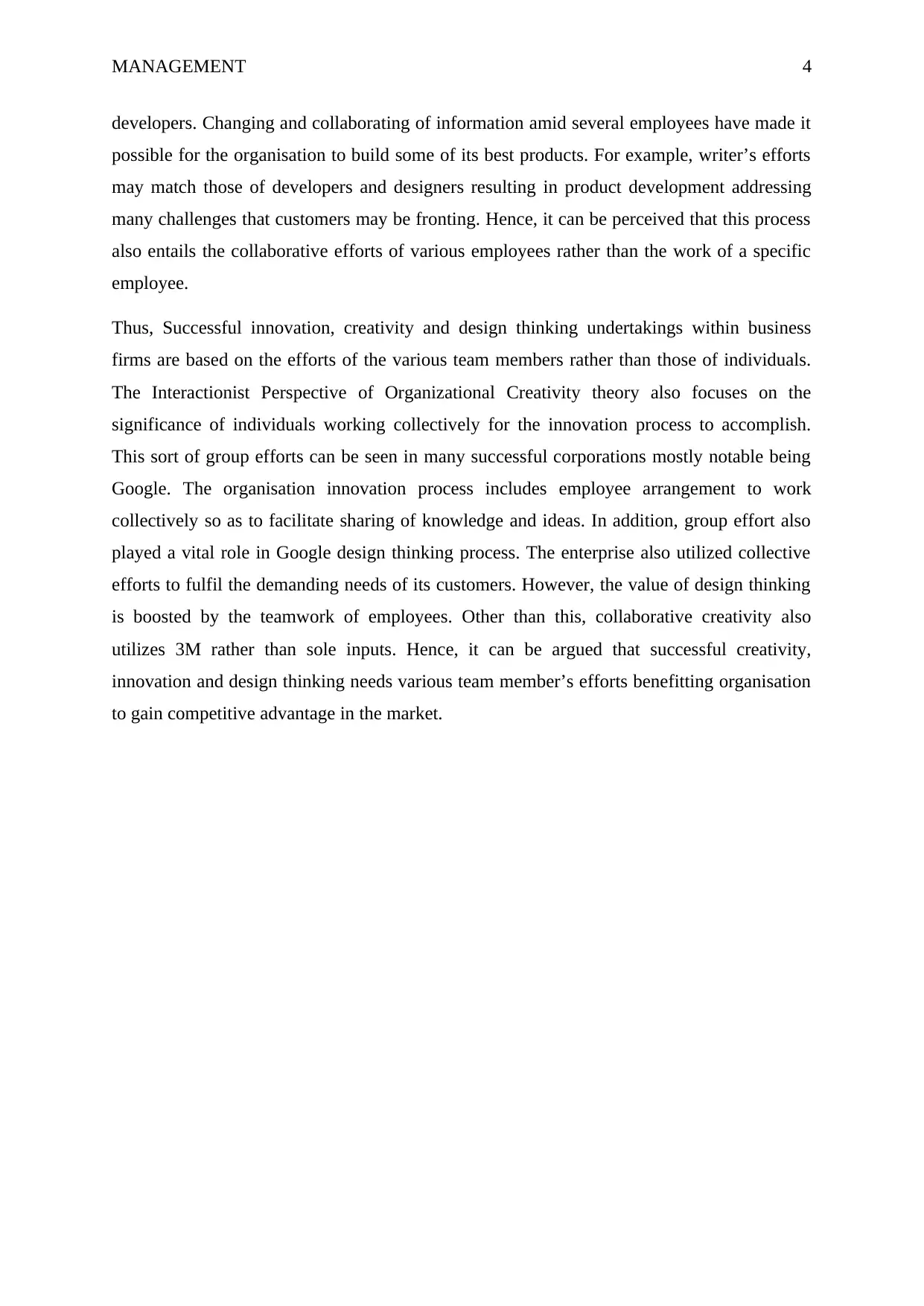
MANAGEMENT 4
developers. Changing and collaborating of information amid several employees have made it
possible for the organisation to build some of its best products. For example, writer’s efforts
may match those of developers and designers resulting in product development addressing
many challenges that customers may be fronting. Hence, it can be perceived that this process
also entails the collaborative efforts of various employees rather than the work of a specific
employee.
Thus, Successful innovation, creativity and design thinking undertakings within business
firms are based on the efforts of the various team members rather than those of individuals.
The Interactionist Perspective of Organizational Creativity theory also focuses on the
significance of individuals working collectively for the innovation process to accomplish.
This sort of group efforts can be seen in many successful corporations mostly notable being
Google. The organisation innovation process includes employee arrangement to work
collectively so as to facilitate sharing of knowledge and ideas. In addition, group effort also
played a vital role in Google design thinking process. The enterprise also utilized collective
efforts to fulfil the demanding needs of its customers. However, the value of design thinking
is boosted by the teamwork of employees. Other than this, collaborative creativity also
utilizes 3M rather than sole inputs. Hence, it can be argued that successful creativity,
innovation and design thinking needs various team member’s efforts benefitting organisation
to gain competitive advantage in the market.
developers. Changing and collaborating of information amid several employees have made it
possible for the organisation to build some of its best products. For example, writer’s efforts
may match those of developers and designers resulting in product development addressing
many challenges that customers may be fronting. Hence, it can be perceived that this process
also entails the collaborative efforts of various employees rather than the work of a specific
employee.
Thus, Successful innovation, creativity and design thinking undertakings within business
firms are based on the efforts of the various team members rather than those of individuals.
The Interactionist Perspective of Organizational Creativity theory also focuses on the
significance of individuals working collectively for the innovation process to accomplish.
This sort of group efforts can be seen in many successful corporations mostly notable being
Google. The organisation innovation process includes employee arrangement to work
collectively so as to facilitate sharing of knowledge and ideas. In addition, group effort also
played a vital role in Google design thinking process. The enterprise also utilized collective
efforts to fulfil the demanding needs of its customers. However, the value of design thinking
is boosted by the teamwork of employees. Other than this, collaborative creativity also
utilizes 3M rather than sole inputs. Hence, it can be argued that successful creativity,
innovation and design thinking needs various team member’s efforts benefitting organisation
to gain competitive advantage in the market.
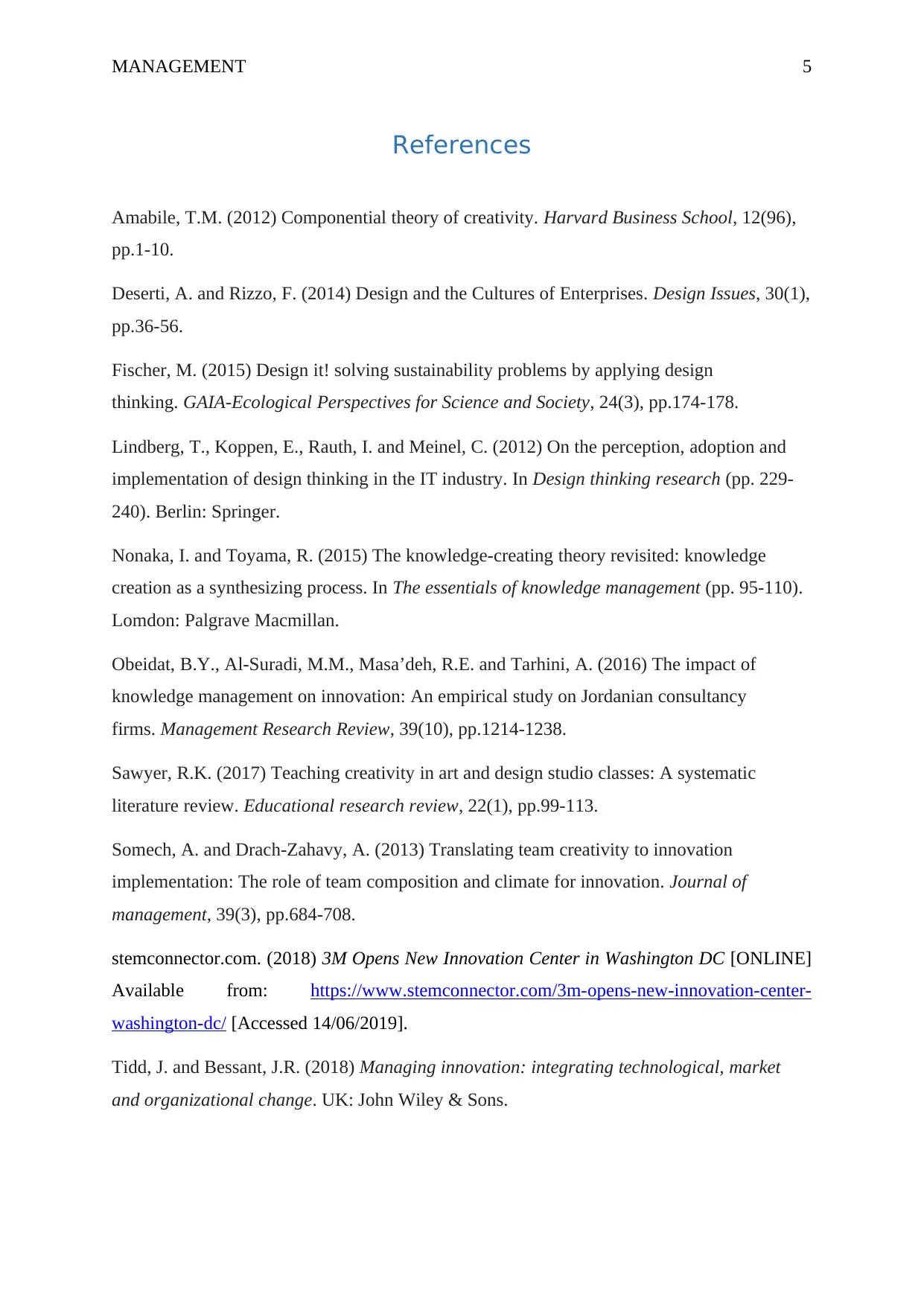
MANAGEMENT 5
References
Amabile, T.M. (2012) Componential theory of creativity. Harvard Business School, 12(96),
pp.1-10.
Deserti, A. and Rizzo, F. (2014) Design and the Cultures of Enterprises. Design Issues, 30(1),
pp.36-56.
Fischer, M. (2015) Design it! solving sustainability problems by applying design
thinking. GAIA-Ecological Perspectives for Science and Society, 24(3), pp.174-178.
Lindberg, T., Koppen, E., Rauth, I. and Meinel, C. (2012) On the perception, adoption and
implementation of design thinking in the IT industry. In Design thinking research (pp. 229-
240). Berlin: Springer.
Nonaka, I. and Toyama, R. (2015) The knowledge-creating theory revisited: knowledge
creation as a synthesizing process. In The essentials of knowledge management (pp. 95-110).
Lomdon: Palgrave Macmillan.
Obeidat, B.Y., Al-Suradi, M.M., Masa’deh, R.E. and Tarhini, A. (2016) The impact of
knowledge management on innovation: An empirical study on Jordanian consultancy
firms. Management Research Review, 39(10), pp.1214-1238.
Sawyer, R.K. (2017) Teaching creativity in art and design studio classes: A systematic
literature review. Educational research review, 22(1), pp.99-113.
Somech, A. and Drach-Zahavy, A. (2013) Translating team creativity to innovation
implementation: The role of team composition and climate for innovation. Journal of
management, 39(3), pp.684-708.
stemconnector.com. (2018) 3M Opens New Innovation Center in Washington DC [ONLINE]
Available from: https://www.stemconnector.com/3m-opens-new-innovation-center-
washington-dc/ [Accessed 14/06/2019].
Tidd, J. and Bessant, J.R. (2018) Managing innovation: integrating technological, market
and organizational change. UK: John Wiley & Sons.
References
Amabile, T.M. (2012) Componential theory of creativity. Harvard Business School, 12(96),
pp.1-10.
Deserti, A. and Rizzo, F. (2014) Design and the Cultures of Enterprises. Design Issues, 30(1),
pp.36-56.
Fischer, M. (2015) Design it! solving sustainability problems by applying design
thinking. GAIA-Ecological Perspectives for Science and Society, 24(3), pp.174-178.
Lindberg, T., Koppen, E., Rauth, I. and Meinel, C. (2012) On the perception, adoption and
implementation of design thinking in the IT industry. In Design thinking research (pp. 229-
240). Berlin: Springer.
Nonaka, I. and Toyama, R. (2015) The knowledge-creating theory revisited: knowledge
creation as a synthesizing process. In The essentials of knowledge management (pp. 95-110).
Lomdon: Palgrave Macmillan.
Obeidat, B.Y., Al-Suradi, M.M., Masa’deh, R.E. and Tarhini, A. (2016) The impact of
knowledge management on innovation: An empirical study on Jordanian consultancy
firms. Management Research Review, 39(10), pp.1214-1238.
Sawyer, R.K. (2017) Teaching creativity in art and design studio classes: A systematic
literature review. Educational research review, 22(1), pp.99-113.
Somech, A. and Drach-Zahavy, A. (2013) Translating team creativity to innovation
implementation: The role of team composition and climate for innovation. Journal of
management, 39(3), pp.684-708.
stemconnector.com. (2018) 3M Opens New Innovation Center in Washington DC [ONLINE]
Available from: https://www.stemconnector.com/3m-opens-new-innovation-center-
washington-dc/ [Accessed 14/06/2019].
Tidd, J. and Bessant, J.R. (2018) Managing innovation: integrating technological, market
and organizational change. UK: John Wiley & Sons.
⊘ This is a preview!⊘
Do you want full access?
Subscribe today to unlock all pages.

Trusted by 1+ million students worldwide

MANAGEMENT 6
Wojcicki, S. (2011) The Eight Pillars of Innovation [ONLINE] Available from:
https://www.thinkwithgoogle.com/marketing-resources/8-pillars-of-innovation/ [Accessed
14/06/2019].
Wojcicki, S. (2011) The Eight Pillars of Innovation [ONLINE] Available from:
https://www.thinkwithgoogle.com/marketing-resources/8-pillars-of-innovation/ [Accessed
14/06/2019].
1 out of 7
Related Documents
Your All-in-One AI-Powered Toolkit for Academic Success.
+13062052269
info@desklib.com
Available 24*7 on WhatsApp / Email
![[object Object]](/_next/static/media/star-bottom.7253800d.svg)
Unlock your academic potential
Copyright © 2020–2025 A2Z Services. All Rights Reserved. Developed and managed by ZUCOL.




